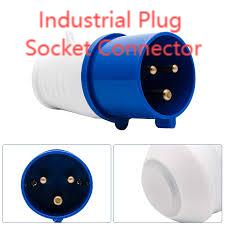Deploy Nante’s Industrial Plug Socket Connector for Mission-Critical Systems

In demanding industrial settings, the adoption of an Industrial Plug Socket Connector can dramatically improve both operational efficiency and safety. By integrating a robust sealing mechanism and precision-engineered contacts, an Industrial Plug Socket Connector offers dependable connections that resist vibration, moisture intrusion, and chemical exposure. These connectors are designed to endure rigorous factory conditions, ensuring uninterrupted power delivery to heavy machinery, lighting systems, and control panels without frequent maintenance or replacement.
Industrial operations often expose electrical components to extreme stressors, including temperature swings, corrosive substances, and mechanical shocks. To address these challenges, modern connectors feature high-grade plastic or metal housings that withstand impact and resist degradation from oils, solvents, and UV rays. Internally, gold- or nickel-plated contacts maintain low-resistance pathways while preventing corrosion. Sealing elements, such as O-rings or gaskets made from silicone or EPDM rubber, fend off water and dust, preserving contact integrity even in washdown environments.
Another critical advantage lies in the connector’s modular design. A typical assembly comprises an interchangeable plug and socket pair. Technicians can quickly decouple the plug from the socket for inspection or replacement without disturbing adjacent circuits. This hot-swap capability minimizes downtime, a key benefit when servicing production lines or critical infrastructure. Color-coded housings and keyed pin configurations further reduce installation errors by ensuring that only matching pairs mate together.
Ergonomics also play a significant role. Many connector lines incorporate flanged grips, quick-release levers, or bayonet locks to simplify engagement and disengagement, even when wearing protective gloves. Clear visual indicators—such as integrated LEDs—can confirm proper mating or alert operators to voltage presence. In applications where space is limited, low-profile designs allow for compact panel layouts without sacrificing current-carrying capacity.
Customization options expand the connector’s versatility. Manufacturers can specify the number of poles, amperage rating, and choice of cable gland sizes to match each application’s requirements. Some variants include integrated fuse holders or grounding contacts for added protection. For harsh outdoor or washdown areas, IP67 or higher ingress-protection ratings ensure that the connectors remain watertight under submersion or high-pressure washes. When paired with heavy-duty cables and strain-relief boots, these assemblies form complete power-distribution sub-systems adaptable to diverse industrial tasks.
Quality assurance processes underpin each connector’s reliability. Incoming materials undergo rigorous testing for tensile strength and chemical resistance. Automated assembly stations precisely crimp or weld conductors onto contacts, while optical and electrical inspections verify dimensional accuracy and conductivity. Final units pass through environmental chambers that simulate temperature extremes, humidity cycles, and salt-fog exposure. This comprehensive validation program guarantees that every connector meets or exceeds industry standards before reaching the production floor.
As factories adopt automation and robotics, the importance of secure, maintenance-free connections grows. Robots and automated guided vehicles (AGVs) rely on uninterrupted power, and any connector failure can halt an entire production cell. By employing connectors designed for continuous plugging cycles and reinforced against repetitive motion fatigue, integrators can maintain high throughput and reduce unscheduled stoppages. Similarly, in mission-critical facilities—such as data centers or hospitals—robust connectors protect backup generators and power-distribution units, safeguarding essential services.
Environmental sustainability is an emerging priority. Many connector manufacturers now use recyclable polymers and eco-friendly plating processes. Modular designs facilitate component-level replacement rather than discarding entire assemblies, reducing electronic waste. Energy-efficient production methods, such as low-temperature molding and solvent-free cleaning, further minimize the ecological footprint. By selecting connectors built with circular-economy principles, companies advance both operational resilience and corporate responsibility goals.
Looking ahead, the integration of smart capabilities will redefine connector performance. Embedded sensors can monitor temperature rises, contact resistance changes, and insertion cycles, transmitting data to maintenance platforms for predictive analytics. Wireless communication modules may enable real-time diagnostics without wiring additional probes. As the Industrial Internet of Things (IIoT) matures, connectors will evolve into active components within intelligent power networks, enhancing visibility and control across entire manufacturing ecosystems.For detailed specifications and ordering information, visit www.nante.com/product/
- Art
- Causes
- Crafts
- Dance
- Drinks
- Film
- Fitness
- Food
- Games
- Gardening
- Health
- Home
- Literature
- Music
- Networking
- Other
- Party
- Religion
- Shopping
- Sports
- Theater
- Wellness


